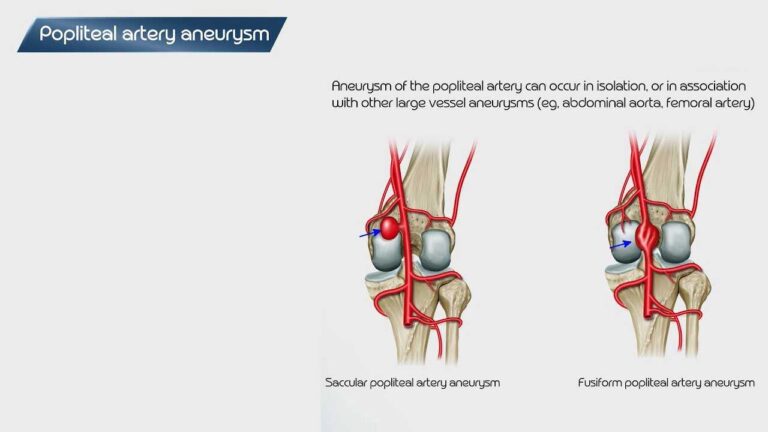Popliteal artery aneurysm is an irregular bulge that happens in the wall of the artery located behind the knee joint. It is a kind of lower extremity aneurysm.
SYMPTOMS
A popliteal artery aneurysm might not cause any noticeable symptoms. The first symptom may be a pain in the lower leg that happens with walking (claudication). Other signs and symptoms of a popliteal artery aneurysm involve:
- Knee pain
- Lower leg pain
- Swelling behind the knee
- Pulsing sensation behind the knee
CAUSES
An aneurysm is ballooning in a weak area in an artery wall. Many different things could cause the popliteal artery wall to become weak, including:
- Clogged arteries (atherosclerosis)
- High blood pressure
- Wear and tear of the popliteal artery because of repetitive use of the knee joint
- Weakening of the artery wall
RISK FACTORS
Popliteal artery aneurysms are uncommon. They occur more frequently among men than women.
Popliteal artery aneurysms often happen in men with abdominal aortic aneurysms (AAA), swelling of the wall of the body’s main artery (aorta). Anyone diagnosed with a popliteal artery aneurysm must be screened for AAA.
Other risk factors for popliteal artery aneurysm involve:
- Increasing age
- High blood pressure (hypertension)
- Smoking
- Narrowing of a heart valve (stenotic disease)
- Having three or more aneurysms anywhere in your body
COMPLICATIONS
Complications of popliteal artery aneurysm involve blood clots (thrombosis) and, rarely, rupture of the aneurysm. Thrombosis of a popliteal artery aneurysm could cause a severe lack of blood flow (ischemia) in the lower leg, which might result in loss of the limb.
Sudden leg ischemia could cause the following signs and symptoms:
- A change in skin color within the affected region
- No pulse behind the knee
- Skin in the affected region feels cold
- Numbness in the leg
- Inability to move the foot
The risk of popliteal artery aneurysm rupture is unlikely.
PREVENTION
Smoking and high blood pressure (hypertension) increase the risk of blood vessel (vascular) problems that could lead to the popliteal artery and other aneurysms. Following a heart-healthy lifestyle — such as not smoking, eating a nutritious diet, and getting regular exercise — could help prevent heart disease and blood vessel damage.
DIAGNOSIS
To diagnose a popliteal artery aneurysm, a health care provider will usually do a physical examination to check for swelling, tenderness, or changes in skin color or temperature on the lower leg and behind the knee. You might be asked questions about your medical history and health habits, such as smoking.
Tests
Imaging tests could help confirm a diagnosis of a popliteal artery aneurysm. If you have signs and symptoms of a popliteal artery aneurysm, your health care provider might recommend:
- Duplex ultrasound – This non-invasive test uses sound waves to check how blood flows through the arteries and veins. It is a simple and quick way to diagnose a popliteal artery aneurysm. For the test, a health care professional gently moves a small hand-held device (transducer) on the skin behind and around the knee.
- CT angiography or magnetic resonance (MR) angiography – CT and MR angiography provides detailed pictures of blood flow in the arteries. Before the pictures are taken, a contrast dye is injected into a blood vessel. The dye helps the arteries appear more clearly.
TREATMENT
Treatment of popliteal artery aneurysm depends upon the size of the aneurysm, the symptoms, and a person’s age and overall health.
Treatment might include:
- Watchful waiting – This means you will have frequent check-ups and ultrasound tests to monitor the aneurysm, especially if the aneurysm is small.
- Medications – Aspirin or another blood thinner (anticoagulant) is generally prescribed for people with popliteal artery aneurysm. Anticoagulants might need to be given by IV. Blood pressure and cholesterol medications also might be recommended to manage heart disease signs and symptoms.
- Surgery – Open surgery to repair the damaged artery is generally recommended for any sized popliteal artery aneurysm that is causing symptoms or for any popliteal artery aneurysm that is 0.8 inches (two centimeters) or larger. Sometimes, a less invasive procedure (endovascular repair) might be done to place a stent inside the popliteal artery to hold it open.
If you or anyone you know is suffering from popliteal artery aneurysm, our expert providers at Specialty Care Clinics will take care of your health and help you recover.
Call 469-545-9983 to Book a telehealth appointment for an at-home check-up.




